#publication year 1967
Explore tagged Tumblr posts
Text


looked on the bookshelf at the local bar and found this
#publication year 1967#obsessed with how many ao3 tags are packed in here#hashtag major character injury#hashtag infidelity#hashtag swingers#etc etc
9 notes
·
View notes
Text
In November, Israel’s public broadcaster, Kan, uploaded on its official X page a video of Israeli children singing a song celebrating their country’s ongoing genocide of Palestinians in Gaza. The broadcaster deleted the video clip after a huge online backlash. Even after the video was silently erased from social media, however, the song remained a subject of discussion and controversy. Many across the world were shocked to see children sing happily about “eliminating” an entire people “within one year”. Yet a closer look at Israeli literature and curricula shows this open celebration of genocide was the only natural outcome of Israel’s persistent indoctrination – or brainwashing to be more blunt – of its children to ensure that they do not view Palestinians as human and fully embrace apartheid and occupation. There is myriad evidence of Israel’s brainwashing of its citizens to erase the humanity of Palestinians spanning many decades. Israeli scholar Adir Cohen, for example, analysed for his book titled “An Ugly Face in the Mirror – National Stereotypes in Hebrew Children’s Literature” some 1700 Hebrew-language children’s books published in Israel between 1967 and 1985, and found that a whopping 520 of them contained humiliating, negative descriptions of the Palestinians. He revealed that 66 percent of these 520 books refer to Arabs as violent; 52 percent as evil; 37 percent as liars; 31 percent as greedy; 28 percent as two-faced and 27 percent as traitors.
. . . continues at Al Jazeera (13 Des 2023)
#i remember being taught in school that the indoctrination of children was one of the reasons why the israel-palestine ''conflict''#was so ~ complicated ~#but of course according to our teachers and our school books this was a sin only the palestinians were guilty of - never the israelis#palestine#israel#gaza
2K notes
·
View notes
Note
Jews were kicked out of Libya because they were overwhelmingly zionist and Libyans didn’t want genocide enablers living in their country. Nothing to do with antisemitism
You say that ‘Libyans’ didn’t want us living in ‘their’ country as though Libyan Jews were never Libyans and Libya was never our country. Perhaps you’re right, considering the Arab government of Libya denied us citizenship, stole our property, raided our homes, and allowed Arab Libyans to terrorize and murder us in the streets. That wasn’t happening to Arab Libyans, because apparently they are ‘real Libyans’ and we were not, right? If we weren’t ’real Libyans’ then what were we? If Libya was not ours, where was ours? You will not like the answer….
349 notes
·
View notes
Text
Welcome to the wonderful world of Arsène Lupin Copyright Shenanigans
Have I ever told y’all about the absolute madness that is the legal issues around the Lupin franchise ? Probably. Can I find the post in question ? No. Am I going to tell you again ? You fucking bet !
The year is 1905, and detective stories are all the rage. Maurice Leblanc, a young writer, is commissioned by the magazine Je Sais Tout to write a short story on the same model as Sherlock Holmes. Maurice Leblanc says « Screw this detective shit », and creates the character of Arsène Lopin, gentleman thief.
No, this is not a typo.
Arsène Lopin, a municipal advisor in Paris, hears about it and contacts Leblanc. « You are not fucking writing a story about a thief who shares my name. » To which Leblanc replied, « Lopin ? No no, you misunderstand, this is Arsène Lupin, completely different person. »
And he gets away with it.
Leblanc writes a bunch more stories about Arsène Lupin, they get popular, and he decides he wants to write a crossover with the famous British detective, Sherlock Holmes. A crossover in which, of course, Lupin will win and Holmes will be humiliated.
Arthur Conan Doyle hears about it, and is not thrilled. He contacts Maurice Leblanc with a message along the lines of « You are not fucking writing a story where my Amazing-Original-Character-Do-Not-Steal gets bested by a thief. » To which Leblanc replies, « Sherlock Holmes? No no, you misunderstand, this is Herlock Sholmes, completely different person. »
And he gets away with it.
The years pass, more Lupin stories are written, they’re translated and exported outside of France, and wouldn’t you know it, Japan takes a strong liking to the « gentleman thief » archetype in general and to Arsène Lupin in particular.
The years is 1967, and mangaka Kazuhiko Kato, best known by his pen name Monkey Punch, is commissioned by the magazine Weekly Manga Action to create a manga for their first issue. He reads 15 of Leblanc’s stories, and creates Lupin the Third, a character who is the grandson of the famous gentleman thief. He does not bother asking the Leblanc Estate for permission, as Japan doesn’t give much of a crap about French copyright laws.
(For the record, Weekly Manga Action was the first manga magazine for an adult audience (outside of erotica), and Lupin III was published in its first issue, effectively making it one if not the very first adult manga in the history of manga.)
The Lupin III manga gets popular, is adapted into an anime, the anime gets popular, it gets translated into other languages and exported to Europe…
And then the Leblanc estate rears its head. «You are not making an anime about our character without paying us fucking royalties, » they say to Monkey Punch. To which Monkey Punch, channeling the spirit of the deceased Maurice Leblanc into his very soul, replies : « Lupin ? No no, you misunderstand, this is Rupan, completely different person. »
And he fucking gets away with it.
(Arsène Lupin became public domain in France in 2012. Before that, Lupin the Third took many different names in European releases, among which Rupan, Wolf, and in France, Edgar de la Cambriole (Edgar of Burglary).)
Additional tomfuckery :
The year is 1982, and science-fiction animated series are getting extremely popular. TMS decides to try and get a slice of the cake, and begins the development of Lupin VIII, a sci-fi spinoff about Lupin III’s descendant. The anime is being produced in France, and the Leblanc Estate once again rears its head. « Sure, you can make that anime, » they say, « but pay us fucking royalties. » TMS, as previously established, does not want to pay the Leblanc Estate diddly squat, and so they scrap half of the project, recycle the other half, and go « Lupin VIII ? No no, you misunderstand, this is Inspector Gadget, completely different person. »
The year is 1930, and famous Japanese writer Tarō Hirai writes The Golden Mask, a novel in which his detective character Kogoro Akechi goes up against none other than Arsène Lupin. Hirai’s pen name was Edgar Allan Poe- wait, wait, no, sorry, it’s Edogawa Ranpo, completely different person.
(Later, Gosho Aoyama names his character, Detective Conan Edogawa, after Arthur Conan Doyle and Edogawa Rampo (and the anime is distributed by TMS).)
(More than fifty years later, the Lupin III anime makes a tribute to Ranpo’s Gold Mask with the double episode The Imperial City Dreams of Thieves.)
The year is 2021, and Capcom is releasing the video game The Great Ace Attorney Chronicles, in which famous detective Sherlock Holmes plays a central role. Unfortunately for them, a few Sherlock Holmes stories are still under copyright, and the Conan Doyle Estate is about as stubborn and greedy as their French cousins. « Pay us fucking royalties, » they say.
In the English release of the game, Sherlock Holmes is renamed to, you guessed it...
...fucking Herlock Sholmes.
#elliott's nerd corner#the hobbit rambles#lupin iii#lupin the third#arsène lupin#maurice leblanc#sherlock holmes#arthur conan doyle
679 notes
·
View notes
Text
Palestinian human rights organizations have shown that one in five Palestinians has been arrested and charged in Israeli military courts since the occupation of the West Bank and the Gaza Strip in 1967. Each year, this figure adds approximately 500–700 Palestinian children, some as young as 12, who are detained and prosecuted in Israeli military courts.
[...] During the ongoing genocidal war across historic Palestine, Israeli carceral violence and arrest campaigns have only intensified. In the months prior to October 7, an approximate 5,200 Palestinians were detained in Israeli prisons. As of mid-March, that number exceeds 9,000. Over the past five months alone, Israeli occupying forces have arrested over 7,600 Palestinians in the West Bank, in addition to an unknown number of detained Gazans. Conditions are worsening for the imprisoned. Immediately following the war’s outbreak, the Israel Prison Service (IPS) placed prisoners in total isolation, prevented them from leaving their cells, and restricted access to water and electricity. The agency ceased providing what had already been poor-quality medical care and has dispensed inadequate food, enacting a starvation campaign against prisoners. Guards inflict violence, torture, and degrading treatment such as reportedly forcing captives to “bark.” IPS also banned visits for family members and delegates from the International Committee of the Red Cross, and severely restricted lawyer visits—cutting prisoners off from the outside world. My research inside Israeli military courts and prison visitation rooms—both as an anthropological researcher and a family member of prisoners—highlights the systematic nature of this violence and its justification through legal codes. Through an intricate web of military laws and orders, Palestinians become racialized—a sociopolitical process through which groups are seen as distinct “races” ordered in a social hierarchy. The Israeli carceral system racializes Palestinians as inherently “criminal” and thus deserving of punishment. Following the occupation of the West Bank and the Gaza Strip in 1967, the Israeli military was vested with the ultimate authority of government, legislation, and punishment over the Palestinian population. This includes prosecuting Palestinians in military courts and charging them under the nearly 1,800 military orders that govern every aspect of daily life: conduct, property, movement, evacuation, land seizures, detention, interrogation, and trial. The orders include provisions for indefinitely detaining Palestinians without charge or trial through a policy inherited from British colonial practices. Over 3,500 Palestinians are being held in this state as of early March. Other provisions regulate the arrest and interrogation of Palestinians and how long they can be denied lawyer visits. With a near 100 percent conviction rate, Israeli military courts hand down absurdly high sentences, sometimes amounting to dozens of life sentences. Torture inside Israeli prisons and detention facilities is sanctioned by Israeli High Court of Justice (HCJ) rulings that permit the exercise of violence under pretexts of “security” and protecting “public order.” Enmeshed within this carceral reality is Israel’s labeling of most Palestinian prisoners as “security prisoners.” This designation masks the political nature of their imprisonment and sanctions violations against them. As opposed to Palestinian “security prisoners,” incarcerated Jewish settler-citizens receive rights such as making telephone calls, going on home visits under guard, the possibility of furlough, and conjugal visits. These rights are denied to the mostly Palestinian security prisoners, who are viewed and racialized from the start as criminals.
26 March 2024
582 notes
·
View notes
Text
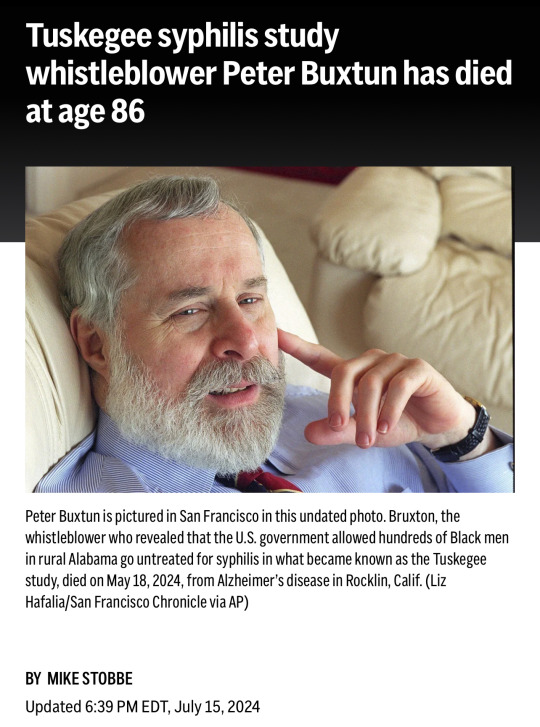
NEW YORK (AP) — Peter Buxtun, the whistleblower who revealed that the U.S. government allowed hundreds of Black men in rural Alabama to go untreated for syphilis in what became known as the Tuskegee study, has died. He was 86.
Buxtun died May 18 of Alzheimer’s disease in Rocklin, California, according to his attorney, Minna Fernan.
Buxtun is revered as a hero to public health scholars and ethicists for his role in bringing to light the most notorious medical research scandal in U.S. history. Documents that Buxtun provided to The Associated Press, and its subsequent investigation and reporting, led to a public outcry that ended the study in 1972.
Forty years earlier, in 1932, federal scientists began studying 400 Black men in Tuskegee, Alabama, who were infected with syphilis. When antibiotics became available in the 1940s that could treat the disease, federal health officials ordered that the drugs be withheld. The study became an observation of how the disease ravaged the body over time.
In the mid-1960s, Buxtun was a federal public health employee working in San Francisco when he overheard a co-worker talking about the study. The research wasn’t exactly a secret — about a dozen medical journal articles about it had been published in the previous 20 years. But hardly anyone had raised any concerns about how the experiment was being conducted.
“This study was completely accepted by the American medical community,” said Ted Pestorius of the U.S. Centers for Disease Control and Prevention, speaking at a 2022 program marking the 50th anniversary of the end of the study.
Buxtun had a different reaction. After learning more about the study, he raised ethical concerns in a 1966 letter to officials at the CDC. In 1967, he was summoned to a meeting in Atlanta, where he was chewed out by agency officials for what they deemed to be impertinence. Repeatedly, agency leaders rejected his complaints and his call for the men in Tuskegee to be treated.
He left the U.S. Public Health Service and attended law school, but the study ate at him. In 1972, he provided documents about the research to Edith Lederer, an AP reporter he had met in San Francisco. Lederer passed the documents to AP investigative reporter Jean Heller, telling her colleague, “I think there might be something here.”
Heller’s story was published on July 25, 1972, leading to Congressional hearings, a class-action lawsuit that resulted in a $10 million settlement and the study’s termination about four months later. In 1997, President Bill Clinton formally apologized for the study, calling it “shameful.”
The leader of a group dedicated to the memory of the study participants said Monday they are grateful to Buxtun for exposing the experiment.
“We are thankful for his honesty and his courage,” said Lille Tyson Head, whose father was in the study.
(continue reading)
#politics#peter buxtun#whistleblowers#tuskegee experiments#black history#medical racism#rip hero 🫡#rest in peace
350 notes
·
View notes
Text
john giving paul a bracelet: fact or fiction?

a lot of mclennon fics feature this silver ID bracelet of paul being given to him by john
so did john give paul a metal bracelet with his name on it?
this one is completely just a theory which lands it in

not too crazy much to get into source wise w this one because it's solidly theory/headcanon territory but i'll explain anyway for anyone that doesn't know The Bracelet Lore!
this one comes at me from @life-under-calico-skies :

Hello! First of all; THANK YOU for your blog! Omg! It was much needed! My question is; did John really give THE bracelet to Paul? It makes sense bc of the timing and when Paul wears it or not - so I WANT to believe it so bad. But I don't think I ever saw ONE reliable source saying that he once gave him a bracelet (or any other jewel, for that matter)
first of all thank YOU! i'm glad you enjoy the blog <3
but you're totally right- there's nothing other than the timing/when paul wears it and as near as i can tell, there's no source on it whatsoever, just people tinhatting. so we can't necessarily say it's Untrue, but it's a bit like speculating that they started a sexual relationship in hamburg or that x song was written about y... there's not much in the way of proving one way or another, unless paul comes out and says something different
with that SAID if someone says "john gave paul a bracelet" THAT'S definitely misinformation (intentional or not ofc). it's not fact. it's just a theory & i think somewhere that got a bit lost in translation? but anyway i'll break down what you mean by the timeline so others know wtf we're talking about here lmao
the theory
paul has/had a silver identity bracelet with his name on it. the theory goes that john gave it to him in paris or on paul's 21st bday & paul wore it on and off throughout his life
there's not much to back this up but there's also not much against it? so if you want to believe it that's fully your prerogative. me personally, i think it's a nice thought/headcanon and don't really Believe one way or the other, i just like the idea of it for like fics and shit
so the timeline...

this is the source for the Main pic people use to show the inscription. these pictures were presumably take in late 1963 and published in october of the same year
which also means this one could be earlier as it's also from '63 and the Only place i can find it is on a 1993 trading card saying it was from a "1963 publicity shoot" but i can't find any other photos from the shoot or which shoot it was to tell you what month that was lmao
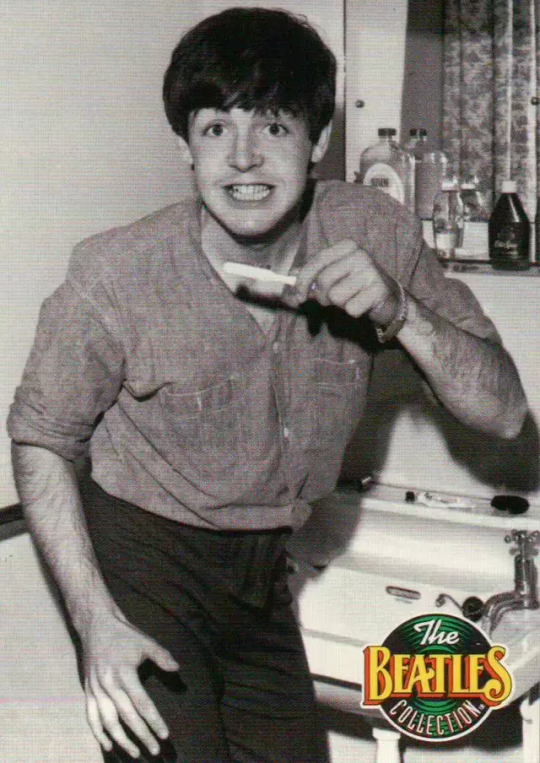

there's also this photo from his 21st birthday party with it, which is Probably the earliest of these two:

which I honestly think is the Most likely time he would've received it, whether from jane or john or whoever else.
and as for the Rest of the timeline i'm pulling from a now deleted post by @ swaying-daisies who seems to have deactivated or changed urls but here's the post anyway. you can see him still wearing it in the 70s, although he stopped wearing it around 1967 for a while it seems

and then you can see it again in anthology:

as for where he got it all he's ever said was this:

"Dear Paul, I waited for three hours in line to see A Hard Day's Night and I thought it was just marv. What wrist do you wear your gold ID bracelet on and where did you get it?" Patricia Parrish BARSTOW, CALIF. "Dear Pat, Glad you enjoyed the film. We've almost finished work on our second movie now- and it's in color this time. Hope everyone enjoys it. I'm left-handed, so it is much easier to wear my watch on my right wrist. Therefore, the bracelet is on my left wrist. Where did I get it? Let's just say it has close sentimental value."
i've seen people say that there's pictures of him from Before 1963 with the bracelet on, but i can't find them.
so the options come down to: it was a gift from jane, it was a gift from john, it was a gift from his mother, or it was a gift from one of his other relatives
a couple of reasons people doubt the jane aspect is that he continued to wear it into the 70s & then ofc people claim that he had it before he met her. i can't find any evidence of him having the bracelet before jane, so i take that with a grain of salt. i'd think for me personally the only thing discounting it from being from jane is the fact the he still wore it during anthology. if it were just the 70s, that might be hand-waved away because it can still take a bit to get rid of everything an ex gave you. but by anthology, he definitely would've been over it.
people also point to him being cagey and saying "let's just say it has close sentimental value" as a reason it's Not from jane, but honestly i don't find that very compelling because at the time of this letter he was still like. out as being with jane, but it was peak beatlemania when they were supposed to be appearing single & approachable. so if it was from jane, i don't think he'd say that here either.
the oooonly other point against it being from jane is simply that i've seen people assert they "know for a fact" that it's from jane because people had matching sweetheart bracelets back then- but she's never seen wearing one. but that's just against them having matching ones, i really don't know if she gave it to him or not.
i don't see any reason that it wouldn't be from a family member that's not his mom, though. if it were his mom, there definitely would've been photos of him wearing it long before 1963. so For Me it comes down to john or another family member. jane is also still a strong possibility to me, although like i said the anthology bit throws a wrench in that for me, unless that's a different bracelet completely. or who knows, maybe he got attached to it outside of her- i've definitely kept things from exes long after i give a shit about them if i'm being honest.
another piece people like to throw in is that in both of the photos of him wearing it after his and john's split, he's wearing it on his right wrist rather than his left, like a widower would if it were a ring. not convincing to me honestly, but it's a part of The Whole Theory/Headcanon bit
others also speculate it could be from ringo! ringo had a similar one and I wouldn't be too surprised if paul liked his so he got him one for his 21st. definitely An option to consider!
also, if anyone knows the exact date on that teeth brushing photo that would be lovely. or if anyone happens to have a photo of him with the bracelet from Before he met jane.
but yeah tl;dr: it's theory, if anyone says it's for sure fact they are misinformed or just really want to believe it. no one knows who gave paul that bracelet and i doubt we'll ever know, so have fun.
#mclennon#checked: neutral#type: factcheck#sorry i went a bit dead yall i'll get to other ones soon !#but yeah basically dont trust any post saying it's for SURE from john#but you can have fun theorizing and headcanoning bc we have no clue where he actually got the damn thing#so your guess is as good as mine unless there's any crazy revelations out there no one's found
174 notes
·
View notes
Text
Some facts about my birthday (October 29):
1390: First trials of witchcraft in Paris
1618: Walter Raleigh, colonialist statesman, soldier, and explorer, is tried for treason and executed
1682: The founder of Pennsylvania, William Penn, lands at what is now Chester, PA
1740: James Boswell, diarist and biographer, is born
1863: The International Red Cross is formed in Geneva
1882: Jean Giradoux, playwright and novelist, is born
1888: The Convention of Constantinople allows for free maritime passage through the Suez Canal; Li Dazhao, co-founder of the CCP and mentor of Mao, is born
1889: N.G. Chernyshevksy, author of "What is to be done?", dies
1897: Joseph Goebbels, the nazi, is born
1901: Leon Czogolsz, anarchist, is executed for the assassination of William McKinley
1910: A.J. Ayer, logical positivist, is born
1914: The Ottomans enter WWI
1923: The Ottoman Empire dissolves; Turkey becomes a republic through the efforts of Atatürk
1924: Zbigniew Herbert, poet, is born
1929: Black Tuesday, the crash of the New York Stock Exchange and the beginning of the Great Depression
1938: Ellen Johnson Sirleaf, president of Rhodesia, is born; Ralph Bakshi, animator, is born
1940: The US begins its first peacetime military draft
1948: Franz de Waal, ethologist, is born
1949: George Gurdjieff, philosopher and mystic, dies
1956: The Suez Crisis begins
1962: The Beach Boys release "Surfin' Safari"
1967: Musical "Hair" opens off Broadway
1969: The first computer-computer link established on ARPANET
1971: Ma Huateng, co-founder of Tencent, is born; Winona Ryder, actor, is born
1975: Franco's 36-year long leadership of Spain ends
1985: Evgeny Lifshitz, physicist, dies
1991: The spacecraft Galileo makes the first ever visit to an asteroid
1995: Terry Southern, screenwriter of Dr. Strangelove, dies
2004: Al-Jazeera broadcasts Osama Bin Laden taking responsibility for 9/11; European Union leaders sign the first EU constitution
It is the Christian feast day of:
Abraham of Rostov
Blessed Chiara Badano
Colman mac Duagh
The Duai Martyrs
Gaetano Erico
Michele Rua
Narcissus of Jerusalem
Theuderius
It is a public holiday in:
Cambodia (Coronation Day)
Turkey (Republic Day)
It is a private holiday in:
USA (National Cat Day)
Everywhere (my birthday)
90 notes
·
View notes
Text
Geology and The Terror
As a geologist who is incapable of turning off their geology brain even while watching shows for fun, one of the things that baffles me a bit about The Terror is why they continuously refer to the landscape as shale when both King William Island and the filming location in Pag, Croatia are dominated by limestone. Given the desolation of the landscape, the geology is rather at the forefront of many scenes so it was fun to try and parse it out as I watched.
King William Island, Nunavut, Canada
According to the official map of the bedrock of the region as published by the Canadian government (Harrison et al., 2015), the entirety of King William Island is mapped as dolostone, dolomitic limestone, and limestone with only minor components of shale, sandstone, conglomerate, and breccia. This is a shelf marine deposit dating back to the Late Cambrian, so this is very old sedimentary rock but younger than most of the surrounding hard rock that composes various parts of the Canadian shield. Notably, the pink units mapped on the Boothia Peninsula are Paleoproterozoic in age (2.5-1.6 billion years old), potentially up to 2 billion years older than the limestones of King William Island.


(This is an absolutely massive .pdf file with some scaled features so I would recommend viewing via the official publication to actually read anything or see fine details: publications.gc.ca/pub?id=9.557274&sl=0)
Notably, this map was published in 2015, 8 years after the novel was written. However, according to the bibliography for the map (which can be accessed via the previous link) a preliminary geologic map has existed for the area since at least 1967, though I was unable to track this publication down online. The novel was clearly thoroughly researched and Dan Simmons could have easily accessed this publication and others through multiple institutions.
The surficial geology of King William Island has also been mapped, and is predominantly glacial, as one would expect given it's location. For those unfamiliar with glacial geology processes, this is basically saying that the bedrock is buried under a bunch of glacial deposits. Glacial till is composed of rocks and sediments plucked from the bedrock and ground up. This is why the surface of the island is not one big rock, but a bunch of smaller pieces. Interestingly, the material on the southern part of the island is sandier because it contains more material derived from the Canadian Shield further south. If you're interested in glacial geology, I highly recommend zooming around a bit on Google Earth because the features here are GORGEOUS.

(This map is absolutely massive and the lines scale with zoom so it's hard to see at this resolution, access it here: publications.gc.ca/pub?id=9.834073&sl=0)

(Google Earth Pro, satellite imagery from 2020)
According to the surface geology map and Google Earth, the actual landscape of King William Island is much more water logged than it appears in the show. It's not entirely impossible that there has been some geomorphological change since 1848, but most of the features mapped would have been formed during the last ice age and as the glaciers melted and not more recently. This would have been handy for the men of the Franklin Expedition because each of these pools is filled with freshwater.
Pag, Croatia
Tracking down a geologic map of Croatia was somewhat challenging as I don't speak Croatian. I was able to find a map of the whole country, and while it's all in Croatian the symbol for the geologic time periods is universal so time periods can be correlated. This shows that the units that make up Pag are Cretaceous and Paleocene-Eocene in age.

(Map accessed here: https://www.hgi-cgs.hr/en/geoloska-karta-republike-hrvatske-1300-000/)
I was able to find a .pdf (access here: http://kig.kartografija.hr/index.php/kig/article/view/158/274) that had a bit more information on the map above but at a lower resolution. This states that the Cretaceous units are dominantly carbonates from the Adriatic sea and the Eocene units are also carbonates. This makes sense as both the Cretaceous and Paleocene-Eocene boundary/PETM are times of increased global temperature correlated with increases in global sea level.
As always, the best geology website out there, Macrostrat, also came through on the unit lithologies. I was unable to access the source listed on Macrostrat, but both the Cretaceous (green) and Paleocene-Eocene units (orange) are listed as limestone.

(Source: https://macrostrat.org/map/#x=16&y=23&z=2)
One of the best views that we get of the geology on Pag is the last scene with Bridgens in episode 9. During the zoom out of this scene we get a really nice view of the bedrock and debris covering it.
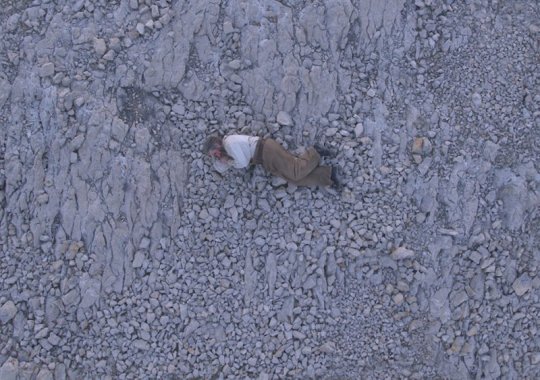
Given all of this, I'm really not sure where the landscape description as shale came from. If there is historical precedence for calling the rocks on the island shale, let me know! I have read a few books but none of the primary sources from the expeditions to this region, so if it comes from that I wouldn't be surprised.
Overall though, I have to say that the filming location was well chosen given the similarities it holds to the geology of King William Island.
#the terror#i have no idea whether this is of interest to anybody else#but i haven't been able to stop thinking about it since i started the show#because obviously the first thing i did was open up macrostrat to see what the geology was like#geology#peter posts#fr though the scene with bridgens is top tier in terms of getting a good view of the geology#it only took me three watches of the show to cave and make a post about it#franklin expedition
126 notes
·
View notes
Text




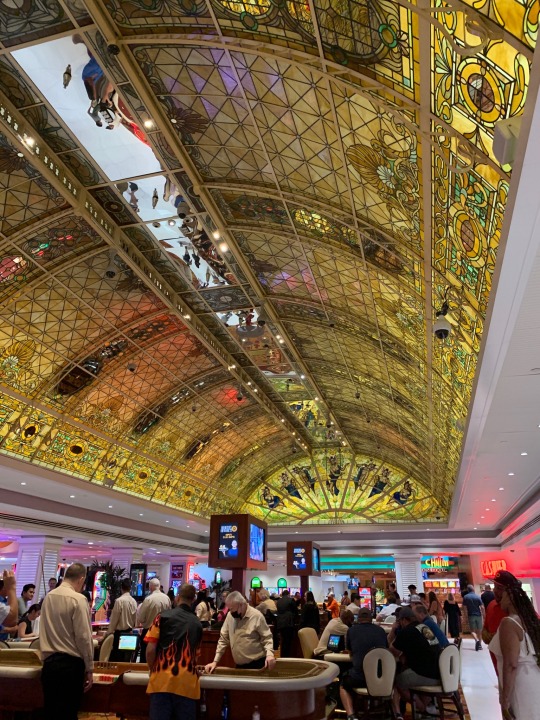
Tropicana, the second-oldest resort casino on the Las Vegas Strip, is closing.
On May 9, 2023, it was announced that a 33,000-seat baseball stadium will be built on the Tropicana site. It has to be removed by late 2024 so construction can start.
The Tropicana dates back to 1955, when hotelier Ben Jaffe, part owner of the Fontainebleau in Miami Beach, purchased the land. Gone is the original showroom where Les Folies Bergère dancers danced for 50 years, where Siegfried & Roy made their Vegas debut in 1967 and where Muhammad Ali held public training sessions for his fight against Ron Lyle in 1975.
Pictured here in the 1950s, 1990s and 2023. Two of my favorite features are the ornate stained-glass ceiling (built in 1979) above the blackjack tables and the bright orange carpet.
411 notes
·
View notes
Text
Milestone Monday

The Morse Dry Dock Dial, 1921

New York Movie, 1939

Houses of Squam Light, 1923

Interior, 1925

Self Portrait, 1904
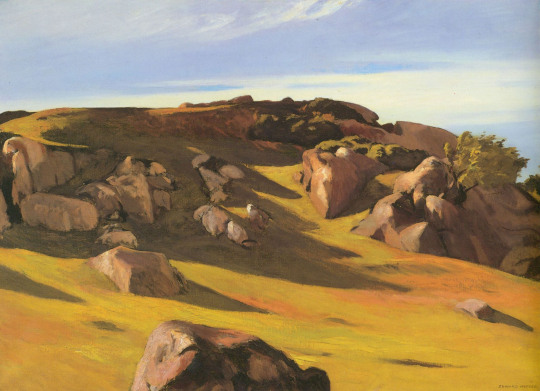
Cape Ann Granite, 1928

Night Windows, 1928

Jo Painting, 1936

Nighthawks, 1942

Cape Cod Morning, 1950
July 22nd marks the birthday of American realist painter and printmaker Edward Hopper (1882-1967). Born in Nyack, New York, Hopper took to art at a young age exploring shadows and shapes through charcoal drawings. By age ten, he started to sign and date his work and, with his parents' encouragement, spent his teen years delving into watercolor and oil painting. Declaring his professional interest in art, Hopper attended the New York School of Art and went on to become a renowned figure in American Realism.
Like many before him, Hopper started his career in commercial illustration to pay the bills but by the late twenties he was supporting himself through showing and selling his paintings. Hopper’s work explores architectural American environments and intimate rural scenes through a lens of solitude. The dramatic moods of his paintings are created through his expertise in capturing light and shadow to convey the subtilties of human experience.
In celebration of the day, we’re sharing Edward Hopper: a catalogue raisonné published in 1995 by Whitney Museum of American Art and edited by art historian Gail Levin (b. 1948). The three-volume catalog is a definitive work on Hopper featuring essays on the artist and hundreds of plates encompassing the entire scope of his career. Scholars will delight at the publication’s inclusion of bibliographic details including provenance and exhibition histories attributed to most pieces.
Read other Milestone Monday posts here.
– Jenna, Special Collections Graduate Intern
#milestone monday#edward hopper#edward hopper a catalogue raisonne#gail levin#whitney museum of american art#oil panting#watercolor#illustration#new york school of art#american realism#birthdays
105 notes
·
View notes
Text
Little Art things I'm obsessed with pt 1
Portraits of absent figures:

David Hockney - A Bigger Splash, 1967
Hockney originally visited California in 1963 and was won over by the sunlight and laid-back lifestyle, especially the luxury and ubiquity of the swimming pool. He described it as his "promised land" The splash is about freezing a moment in time, but it is also empty of human presence but implying a human. The male figure is present in some of David's other works from this time period, especially his muse and then-partner Peter Schlesinger. These paintings are about a hedonistic gay lifestyle, and the swimmers, the divers, are often the subject of voyeurism and desire. But in this painting, we just missed the diver, which makes the object of desire more private and personal. Who was the painter looking at, lusting after, etc. I like the contrast of the incredibly sharp and graphic suburban neighborhood, and the chaotic, organic splash. So again, if the divers represent this homosexual desire, we have this contrast of an orderly heterosexual world, and the queerness that joyfully disrupts it.
And then of course, with the absent figure, there is this massive sense of loss and loneliness. And so much of loneliness is about concealment, hiding in shame. This is a private space, but its also an exposed space, enhancing the loneliness. The figure is isolated, alone, invisible. Its a sadness that contrasts with the setting, the activity, and saturated lighting.

Felix Gonzalez-Torres - Untitled (billboard of an empty bed), 1991
These billboards were exhibited in the streets of Manhattan during the AIDS crisis. This piece was created the same year Felix Gonzalez-Torres's boyfriend Ross died. This portrait is a celebration of love and a memorization of loss and the emotions between intimacy and publicity. In the artist's own words:
“What I’m trying to say is that we cannot give the powers that be what they want, what they are expecting from us. Some homophobic senator is going to have a very hard time trying to explain to his constituency that my work is homoerotic or pornographic, but if I were to do a performance with HIV blood — that’s what he wants, that’s what the rags expect because they can sensationalize that, and that’s what’s disappointing. Some of the work I make is more effective because it’s more dangerous. We both make work that looks like something else but it’s not that. We’re infiltrating that look.“
The work intentionally uses the matching, identical depressions to imply a same-sex couple. The image itself is extremely intimate, but its being displayed in public spaces.
Felix Gonzales-Torres became known for his absent bodies.
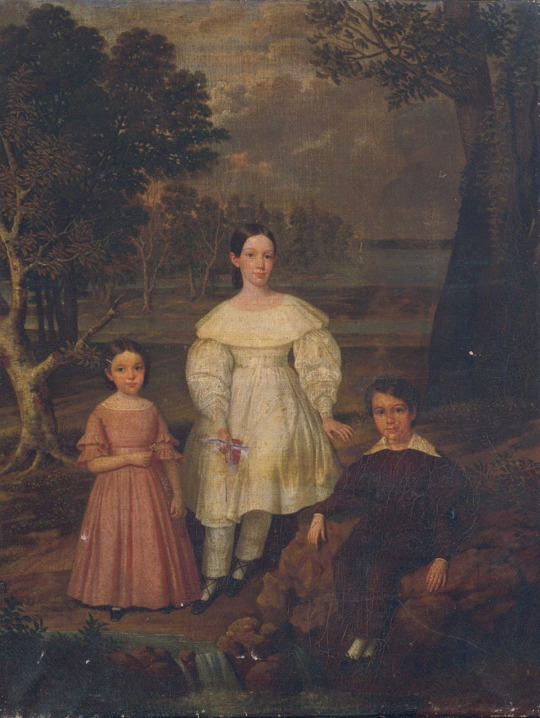
And then, a little different, this painting by Jacques Guillaume Lucien Amans (1837) commissioned by Frederick and and Coralie Frey, depicts the three Frey children, with the faint shadow of a figure. There was a legend that there was a fourth figure in this painting. In 2005 a private collector, Jeremy K Simien, purchased the painting and it underwent conservation.

The painting revealed Bélizaire, a fifteen year-old enslaved domestic owned by the children's father. The picture captures the complex relationship between the boy and the children, the family that was keeping him captive. For one thing, the way he is set back from the others. There is this sort of intimacy between them along side the psychological trauma of forced bondage.
Here is a great Tiktok about the painting, to quote "What I'm struck by is what a sensitive portrait this is of this young man who was living in an inhumane society where he, despite being a human being, was bought and sold."
A few years after this painting was created, the three Frey children died, and Bélizaire was the only one who survived into adulthood.
The painting stayed in the Frey family. At some point, likely in the late 19th or 20th century, Bélizaire was intentionally painted over. In 1972, the great-granddaughter of Coralie Frey donated the painting to a Louisiana museum, informing them that a figure was painted over. During the course of the painting's life at the museum, no effort was put into restoring the figure.
Jeremy Simien's, who bought and restored this painting, said on his instagram "Bélizaire, they know your name now. Tell the ancestors to let me sleep for a minute."
And shout out to the picture that make me want to write this, Hyde Park Flowers, London by Tumblr user @kimironside I won't re-post it so check out the link.
#art#art history#felix gonzalez torres#belizaire#david hockney#Jacques Guillaume Lucien Amans#Jacques Amans#Jeremy K Simien#tw slavery#tw aids
1K notes
·
View notes
Text

Pictured: President Donald Trump and Israeli Prime Minister Benjamin Netanyahu in the Oval Office on March 25, 2019, the day Trump signed a U.S. declaration recognizing Israel’s sovereignty over the Golan Heights, reversing more than a half-century of U.S. policy.
Article
"Former president Donald Trump promised to crush pro-Palestinian protests on college campuses, telling a roomful of donors — a group that he joked included “98 percent of my Jewish friends” — that he would expel student demonstrators from the United States, according to participants in the roundtable event with him in New York.
“One thing I do is, any student that protests, I throw them out of the country. You know, there are a lot of foreign students. As soon as they hear that, they’re going to behave,” Trump said on May 14, according to donors at the event.
When one of the donors complained that many of the students and professors protesting on campuses could one day hold positions of power in the United States, Trump called the demonstrators part of a “radical revolution” that he vowed to defeat. He praised the New York Police Department for clearing the campus at Columbia University and said other cities needed to follow suit, saying “it has to be stopped now.”
“Well, if you get me elected, and you should really be doing this, if you get me reelected, we’re going to set that movement back 25 or 30 years,” he said, according to the donors, who spoke on the condition of anonymity to detail a private event.
Trump has waffled publicly about whether Israel should continue its war in Gaza, saying “get it over with … get back to peace and stop killing people.” Major Republican donors have lobbied him in recent months to take a stronger stance backing Israel and its prime minister, Benjamin Netanyahu.
The private New York meeting offers new insight into his current thinking. Speaking to wealthy donors behind closed doors, Trump said that he supports Israel’s right to continue “its war on terror” and boasted of his White House policies toward Israel...
Trump has offered few policy specifics about how he would treat Israel in a second term. He cast doubt on the viability of an independent Palestinian state in a recent Time magazine interview, saying he was “not sure a two-state solution anymore is gonna work,” adding: “there may not be another idea.” A two-state solution to the Israeli-Palestinian conflict has been the end goal of U.S. policy under Democratic and Republican presidents for decades...
Trump took a different tone [than his public comments] in the meeting with donors. Instead of saying it was time to wrap up the war, he said he supported Israel’s right to continue its attack on Gaza.
“But I’m one of the only people that says that now. And a lot of people don’t even know what October 7th is,” Trump said.
Trump repeatedly listed for the donors everything he believed he had done for Israel in the White House. He moved the U.S. Embassy to Jerusalem, bucking decades of U.S. policy. He recognized the Golan Heights, which Israel seized from Syria in 1967, as an integral part of Israel after what he said was a five-minute conversation with David Friedman, his ambassador there.
He also polled the room if they liked Friedman.
“So I did Golan Heights. You know that’s worth $2 trillion, they said, that piece, if you put it in real estate terms. But it’s worth more than that. It is,” Trump said, according to donors present.
Israel, Trump argued, needs his help. Street demonstrations for Israel get smaller crowds than his rallies, he said. In Washington, and particularly in Congress, “Israel is losing its power,” he added. “It’s incredible.” ...
Trump and Netanyahu’s relationship will “continue to prosper and flourish” if they’re both in office at the same time again, Matthew Brooks, chief executive of the Republican Jewish Coalition, said in an interview.
“He’s giving the Israelis a blank check to go in and do what they need to do to destroy Hamas and eliminate the threat in Gaza from Hamas. And what he’s also saying, which is actually true, he said ‘but do it quickly’ because time is not Israel’s ally right now,” Brooks said."
-via The Washington Post, May 27, 2024
--
Reminder that just because the status quo is fucking bad, that doesn't change the fact that under Trump, it would be fucking worse.
#palestine#free palestine#israel#gaza#cw war#us politics#united states#palestine genocide#free gaza#cw genocide#donald trump#2024 election#election 2024#american politics#2024 presidential election#us elections#trump#fuck trump#palestine protests
72 notes
·
View notes
Text
Steve DeCanio, an ex-Berkeley activist now doing graduate work at M.I.T., is a good example of a legion of young radicals who know they have lost their influence but have no clear idea how to get it back again. “The alliance between hippies and political radicals is bound to break up,” he said in a recent letter. “There’s just too big a jump from the slogan of ‘Flower Power’ to the deadly realm of politics. Something has to give, and drugs are too ready-made as opiates of the people for the bastards (the police) to fail to take advantage of it.” Decanio spent three months in various Bay Area jails as a result of his civil rights activities and now he is lying low for a while, waiting for an opening. “I’m spending an amazing amount of time studying,” he wrote. “It’s mainly because I’m scared; three months on the bottom of humanity’s trash heap got to me worse than it’s healthy to admit. The country is going to hell, the left is going to pot, but not me. I still want to figure out a way to win.”
Re-reading Hunter S. Thompson's 1967 article about Haight-Ashbury, I thought: "huh, this guy sounds like he's going places. I wonder whether he ever did 'figure out a way to win'?"
So I web searched his name, and ... huh!
My current research interests include Artificial Intelligence, philosophy of the social sciences, and the economics of climate change. Several years ago I examined the consequences of computational limits for economics and social theory in Limits of Economic and Social Knowledge (Palgrave Macmillan, 2013). Over the course of my academic career I have worked in the fields of global environmental protection, the theory of the firm, and economic history. I have written about both the contributions and misuse of economics for long-run policy issues such as climate change and stratospheric ozone layer protection. An earlier book, Economic Models of Climate Change: A Critique (Palgrave Macmillan, 2003), discussed the problems with conventional general equilibrium models applied to climate policy. From 1986 to 1987 I served as Senior Staff Economist at the President’s Council of Economic Advisers. I have been a member of the United Nations Environment Programme’s Economic Options Panel, which reviewed the economic aspects of the Montreal Protocol on Substances that Deplete the Ozone Layer, and I served as Co-Chair of the Montreal Protocol’s Agricultural Economics Task Force of the Technical and Economics Assessment Panel. I participated in the Intergovernmental Panel on Climate Change that shared the 2007 Nobel Peace Prize, and was a recipient of the Leontief Prize for Advancing the Frontiers of Economic Thought in 2007. In 1996 I was honored with a Stratospheric Ozone Protection Award, and in 2007 a “Best of the Best” Stratospheric Ozone Protection Award from the U.S. Environmental Protection Agency. I served as Director of the UCSB Washington Program from 2004 to 2009.
I don't know whether this successful academic career would count as "winning" by his own 1967 standards. But it was a pleasant surprise to find anything noteworthy about the guy at all, given that he was quoted as a non-public figure in a >50-year-old article.
81 notes
·
View notes
Text
The U.K.'s last coal-fired power plant was to close permanently on Monday — bringing an end to 140 years of reliance on the fossil fuel to generate electricity in Britain. The move will make the U.K. the first major global economy to completely phase out coal as an energy source.
The Ratcliffe-on-Soar Power Station, located near a small village in southern England, was to close its doors for the last time at midnight local time. The power station has been generating electricity since 1967 and "played a key role in keeping the nation's lights on," its parent company Uniper said in a statement Monday.
"Since commissioning it has produced enough energy to make more than 21 trillion cups of tea and its 2GW capacity is enough to power two million homes," the company said.
Peter O'Grady, the plant's manager, told CBS News it was "an emotional day."
"When I started my career 36 years ago, none of us imagined a future without coal generation in our lifetimes. I am incredibly proud of what we've achieved together over the years and to be part of this energy milestone as the country focuses on a cleaner energy future," he said.
The move sees the U.K. make good on one of the environmental pledges made by the government as part of a wider strategy to combat climate change and achieve net-zero greenhouse gas emissions by 2050. Coal is considered the single most damaging fossil fuel for the environment, according to Greenpeace, as it releases more carbon dioxide than oil or gas. Coal also produces mercury and arsenic, and small particles of soot which contribute to air pollution.
Thirteen countries have already phased out coal as a source of energy, according to independent climate think tank Ember, but Britain will be the only member of the G7 group of economically advanced, democratic nations to do so thus far.
In the G7's largest economy by a significant margin, the U.S., the Department of Energy acknowledges that coal is still "used to generate a significant chunk of our nation's electricity" — about 16% of the total share in 2023, according to the Energy Information Administration.
U.K. Energy Minister Michael Shanks said in a statement sent Monday to CBS News that the closure of the Ratcliffe power station "marks the end of an era, and coal workers can be rightly proud of their work powering our country for over 140 years."
"The era of coal might be ending, but a new age of good energy jobs for our country is just beginning," Shanks said.
The first coal plant in Britain went online in 1882, when Thomas Edison's Holborn Viaduct coal plant started generating electricity for public use. It was a first-of-its-kind station, and it burned enough coal to provide energy to light 1,000 lamps in the City of London.
Despite efforts to make the industry cleaner, the fundamentals of coal-fired electricity generation have remained largely unchanged since Edison's company fired up its boilers. The process involves burning the fossil fuel to heat water to create steam, which spins a turbine to produce electricity.
44 notes
·
View notes
Text
Kenneth Tynan and the Beatles
Shout out to @mmgth for noticing Beatle mentions in the letters of Kenneth Tynan - including working with John Lennon, Paul's 1960s reputation, and glimpses of the breakup. (Alas, no George or Ringo.)
Tynan was a drama critic and later worked with Laurence Olivier at Britain's National Theatre. Philip Norman calls him "the most rigorous cultural commentator of his age": he championed working class plays in the 1950s, supported progressive art (and was widely believed to be the first person to say "fuck" on British television). So he's an interesting perspective: well connected, arty, eager for cultural change, but from an older generation, and outside the immediate rock/pop world.
The first mention is 1966, when Tynan is already working at the National Theatre.
28 September 1966
Dear Mr McCartney,
Playing 'Eleanor Rigby' last night for about the 500th time, I decided to write and tell you how terribly sad I was to hear that you had decided not to do As You Like It for us. There are four or five tracks on 'Revolver' that are as memorable as any English songs of this century - and the maddening thing is that they are all in exactly the right mood for As You like It. Apart from 'E. Rigby' I am thinking particularly of 'For No One' and 'Here, There and Everywhere'. (Incidentally, 'Tomorrow Never Knows' is the best musical evocation of L.S.D. I have ever heard).
To come to the point: won't you reconsider? John Dexter [theatre director] doesn't know I'm writing this - it's pure impulse on the part of a fan. We don't need you as a gimmick because we don't need publicity: we need you simply because you are the best composer of that kind of song in England. If Purcell were alive, we would probably ask him, but it would be a close thing. Anyway, forgive me for being a pest, but do please think it over."
Paul replied that he couldn't do the music because, hilariously, "I don't really like words by Shakespeare" - he sat waiting for a "clear light" but nothing happened. He ended, "Maybe I could write the National Theatre Stomp sometime! Or the ballad of Larry O."
It's interesting that Tynan approaches Paul individually - because they had theatre connections in common? Or did Tynan assume that John wrote the words and Paul the music, so Paul's the guy to ask for settings of Shakespeare lyrics? (Though he does correctly identify Paul songs in his letter, plus the musical setting of Tomorrow Never Knows, so he might just be asking because he's a Paul girl. He also wants Paul to know that he's cool and hip and has done acid.)
Tynan definitely is a Paul girl. On 7 November that year, he pitched possible articles (I think for Playboy). He offers articles on the War Crimes Tribunal (set up by Bertrand Russell on the US in Vietnam), an interview with Marlene Dietrich, or:
"Interview with Paul McCartney - to me, by far the most interesting of the Beatles, and certainly the musical genius of the group."
It's a reminder of how drastically Paul's reputation changed, between cultural commentators of the 1960s and post-breakup.
Tynan didn't get his Paul interview, but he worked twice with John.
On 5 February 1968, he's sorting out practical details for the National Theatre's company manager about about the stage adapation of John's book In His Own Write (which had already had a preview performance in 1967). It's a very Beatle-y affair:
Victor Spinetti and John Lennon will need the services of George Martin, the Beatles A & R man to prepare a sound tape to accompany the Lennon play. Martin did this tape as a favour for the Sunday night production, but something more elaborate will be required when the show enters the rep, and I feel he should be approached on a professional basis as Sound Consultant, or some similar title. I have written to him to find out if he is ready to help and will let you know as soon as he replies.
...John Lennon says that as far as his own contract is concerned, we should deal directly with him at NEMS rather than his publisher.
So John prefers to work within the Beatle structure: George Martin, Victor Spinetti, plus NEMS, rather than pursuing closer ties with his book publisher.
On 16 April 1968, Tynan writes to John about his ideas for a wanking sketch.
Dear John L,
Welcome back. You know that idea of yours for my erotic revue - the masturbation contest? Could you possibly be bothered to jot it down on paper? I am trying to get the whole script in written form as soon as possible.
John's reply is very John:
"you know the idea, four fellows wanking - giving each other images - descriptions - it should be ad-libbed anyway - they should even really wank which would be great..."
Oh John.
Tynan still wanted to interview Paul - and was noticing changes in Beatle dynamics. On 3 September 1968, Tynan pitched another feature on Paul, this time for the New Yorker:
In addition to pieces on theatre, I'd love to try my hand at a profile (I remember long ago we vaguely discussed Paul McCartney though John Lennon is rather more accessible)...
Accessible because Tynan had already worked with him, or because John was already flexing his PR muscles? The New Yorker was interested, because Tynan follows up on 14 October 1968:
4. A few days in the life of Paul McCartney (which we agreed should come at the end of the series of articles, because of the current overexposure of the Beatles.)
Why does he see the Beatles as "overexposed" in autumn 1968, when he hadn't in 1966? Was it the Apple launch? The JohnandYoko press campaign? The cumulative impact of a lot of Beatle news?
Tynan was still trying on 17 September 1969:
...I'd like to go on to either Mr Pinter [playwright Harold Pinter] or Paul McCartney... I incline towards McCartney who has isolated himself more and more in the past from the other Beatles and indeed from the public: he seems to have reached an impasse that might be worth exploring. On the other hand Pinter is a much closer friend and would be more accessible to intimate scrutiny."
I'm fascinated by this - that Paul's isolation was visible to those outside the Beatles circle (the letter is dated three days before the meeting of 20 September 1969, where John said he wanted a divorce).
But Tynan was right about Paul being inaccessible. On 5 January 1970:
I'm saddened to have to tell you that Paul McCartney doesn't want to be written about at the moment - at least, not by me. I gather that for some time now the Beatles have been moving more and more in separate directions. Paul went to a recording session for a new single last Sunday which was apparently the first Beatles activity in which he'd engaged for nearly nine months. He doesn't know quite where his future lies, and above all he doesn't want to be under observation while he decides.
So while Paul "doesn't want to be under observation", he's surprisingly open about the breakup - less blunt than "the Beatle thing is over", which he told Life in November 1969, but still frank.
Trying to persuade Paul to open up to "intimate scrutiny" in 1969 does suggest another reason why 1970s interviewers adored John. Tynan works for an older, more established press, but he's offering the kind of profile John would make his own - discussing his inner life and personal/artistic conflicts with cultural commentator who respects him as an artist. And Paul can't run away fast enough. As a journalist, you'd absolutely go for the guy who makes himself accessible and is eager to bare his soul, over Mr Doesn't Want To Be Written About At The Moment.
#kenneth tynan#the breakup#john lennon#paul mccartney#george martin#victor spinetti#oh! calcutta#john's pr genius is so underrated#tag for mine or my addition
64 notes
·
View notes